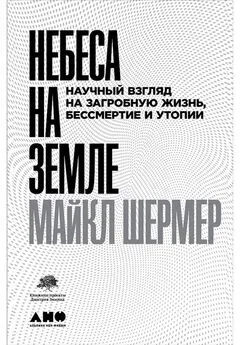Майкл Мобуссин - Больше, чем вы знаете. Необычный взгляд на мир финансов
- Название:Больше, чем вы знаете. Необычный взгляд на мир финансов
- Автор:
- Жанр:
- Издательство:Array Литагент «Альпина»
- Год:2014
- Город:Москва
- ISBN:978-5-9614-3247-3
- Рейтинг:
- Избранное:Добавить в избранное
-
Отзывы:
-
Ваша оценка:
Майкл Мобуссин - Больше, чем вы знаете. Необычный взгляд на мир финансов краткое содержание
Больше, чем вы знаете. Необычный взгляд на мир финансов - читать онлайн бесплатно ознакомительный отрывок
Интервал:
Закладка:
13. Michael J. Mauboussin and Kristen Bartholdson, “Measuring the Moat: Assessing the Magnitude and Sustainability of Value Creation”, Credit Suisse First Boston Equity Research , December 16, 2002.
Заключение. Будущее – за синтезом инвестирования
1. J. Doyne Farmer and Fabrizio Lillo, “On the Origin of Power Law Tails in Price Fluctuations”, Quantitative Finance 4, no. 1 (2004): 7–11.
2. Duncan J. Watts, Small Worlds: The Dynamics of Networks Between Order and Randomness (Princeton N. J.: Princeton University Press, 1999).
3. James H. Brown and Geoffrey B. West, Scaling in Biology (Oxford: Oxford University Press, 2000).
Список литературы
Adamic, Lada A. “Zipf, Power-Laws, and Pareto – a Ranking Tutorial.” Information Dynamics Lab, HP Labs, Working Paper. http://ginger.hpl.hp.com/shl/papers/ranking/ranking.html.
Alvarez, A. Poker: Bets, Bluffs, and Bad Beats. San Francisco: Chronicle Books, 2001.
Anderson, Carl, and John J. Bartholdi III. “Centralized Versus Decentralized Control in Manufacturing: Lessons from Social Insects.” In Complexity and Complex Systems in Industry, ed. Ian P. McCarthy and Thierry Rakotobe-Joel, 92–105. Warwick: University of Warwick, 2000.
Armstrong, J. Scott. “The Seer-Sucker Theory: The Value of Experts in Forecasting.” Technology Review 83 (June – July 1980): 16–24.
Arthur, W. Brian. “Increasing Returns and the New World of Business.” Harxvard Business Review (July – August 1996): 101–9.
____. “Inductive Reasoning and Bounded Rationality: The El Farol Problem”. Этот доклад был прочитан на ежегодном съезде Американской экономической ассоциации в 1994 г. и опубликован в журнале American Economic Review 84 (1984): 406–11, http://www.santafe.edu/arthur/Papers/El_Farol.html.
Asch, Solomon E. “Effects of Group Pressure Upon the Modification and Distortion of Judgment.” In Groups, Leadership, and Men, ed. Harold Guetzkow, 177–90. Pittsburgh: Carnegie Press, 1951.
Aunger, Robert. The Electric Meme: A New Theory of How We Think. New York: Free Press, 2002.
Axelrod, Robert. The Complexity of Cooperation: Agent-Based Models of Competition and Collaboration. Princeton, N. J.: Princeton University Press, 1997.
____. The Evolution of Cooperation. New York: Basic Books, 1984.
Axelrod, Robert, and Michael D. Cohen. Harnessing Complexity. New York: Free Press, 1999.
Axtell, Robert. “The Emergence of Firms in a Population of Agents: Local Increasing Returns, Unstable Nash Equilibria, and Power Law Size Distributions.” Brookings Institution, Center on Social and Economics Working Paper, June 3, 1999.
____. “Zipf Distribution of U. S. Firm Sizes.” Science 293 (September 2001): 1818–20.
http://www.sciencemag.org/content/vol293/issue5536/index.shtml.
____. “Zipf’s Law of City Sizes: A Microeconomic Explanation Far from Equilibrium.” Доклад на семинаре RAND «Сложные системы и стратегический анализ: новые инструменты для нового тысячелетия», 27–28 сентября 2000 г., Арлингтон, Вайоминг.
Axtell, Robert L., and Richard Florida. “Emergent Cities: A Microeconomic Explanation of Zipf ’s Law.” Brookings Institution and Carnegie Mellon University Working Paper, September 2000.
Baer, Gregory, and Gary Gensler. The Great Mutual Fund Trap. New York:
Broadway Books, 2002.
Bak, Per. How Nature Works: The Science of Self-Organized Criticality. New York: Springer-Verlag, 1996.
Barabási, Albert-László. Linked: The New Science of Networks. Cambridge, Mass.: Perseus, 2002.
Barberis, Nicholas, and Ming Huang. “Mental Accounting, Loss Aversion, and Individual Stock Returns.” Journal of Finance 56, no. 4 (August 2001): 1247–92.
Batten, David F. Discovering Artificial Economics: How Agents Learn and Economies Evolve. New York: Westview Press, 2000.
Batty, Michael. “Rank Clocks.” Nature 444 (November 2006): 592–96.
Bazerman, Max. Judgment in Managerial Decision Making. 4th ed. New York: Wiley, 1998.
Bechara, Antoine, Hanna Damasio, Daniel Tranel, and Antonio R. Damasio. “Deciding Advantageously Before Knowing the Advantageous Strategy.” Science 275 (February 1997): 1293–95.
Beinhocker, Eric D. “Robust Adaptive Strategies.” Sloan Management Review 40, no. 3 (Spring 1999): 95–106.
Belsky, Gary, and Thomas Gilovich. Why Smart People Make Big Money Mis – takes – and How to Correct Them: Lessons from the New Science of Behavioral Economics. New York: Simon and Schuster, 1999.
Benartzi, Shlomo, and Richard H. Thaler. “Myopic Loss Aversion and the Equity Premium Puzzle.” The Quarterly Journal of Economics (February 1995): 73–92. http://gsbwww.uchicago.edu/fac/richard. thaler/research/myopic.pdf.
Bennis, Warren. “Will the Legacy Live On?” Harvard Business Review (February 2002): 95–99.
Berkshire Hathaway. Annual Shareholder Letters. http://www.berkshire hathaway.com/letters/letters.html.
Bernoulli, Daniel. “Exposition of a New Theory on the Measurement of Risk.” Econometrica 22 (January 1954): 23–36.
Bernstein, Peter L. Capital Ideas: The Improbable Origins of Modern Wall Street. New York: The Free Press, 1992.
____. Against the Gods: The Remarkable Story of Risk. New York: Wiley, 1996.
____. “Growth Companies vs. Growth Stocks.” Harvard Business Review (September – October 1956): 87–98. Bernstein, William J. “Of Risk and Myopia.” Efficientfrontier.com (2002).
http://www.efficientfrontier.com/ef/102/taleb.htm.
Besanko, David, David Dranove, and Mark Shanley. Economics of Strategy. 2nd ed. New York: John Wiley & Sons, 2000.
Betfair Web site. http://www.betfair.com.
Beyer, Andrew, et al. Bet with the Best: All New Strategies from America’s Leading Handicappers. New York: Daily Racing Form Press, 2001.
Bibliography of Zipf’s Law. http://www.nslij-genetics.org/wli/zipf.
Bikhchandani, Sushil, David Hirshleifer, and Ivo Welch. “Informational Cas – cades and Rational Herding: An Annotated Bibliography.” Working Paper: UCLA/Anderson and Michigan/GSB (June 1996).
Bikhchandani, Sushil, and Sunil Sharma. “Herd Behavior in Financial Markets.” IMF Staff Papers 47, no. 3 (September 2001). http://www.imf.org/External/Pubs/FT/staffp/2001/01/pdf/bikhchan.pdf. “Binary: It’s Digitalicious.” Binary code translation Web site. http://nickciske.com/tools/binary.php.
Bischoff, R. “Informal Learning in the Workplace.” January 26, 1998. http://www.tlrp.org/dspace/retrieve/226/Informal+Learning+in+the+workplace1.doc.
Blakeslee, Sandra. “Scientist at Work: John Henry Holland; Searching for Simple Rules of Complexity.” New York Times, December 26, 1995.
Bogle, John C. “The Emperor’s New Mutual Funds.” The Wall Street Journal, July 8, 2003.
____. “Mutual Fund Directors: The Dog That Didn’t Bark.” January 28, 2001. http://www.vanguard.com/bogle_site/sp20010128.html.
____. “The Mutual Fund Industry in 2003: Back to the Future”, из выступления в Гарвардском клубе в Бостоне 14 января 2003 г.,
http://www.vanguard.com/bogle_site/sp20030114.html.
____. “The Mutual Fund Industry Sixty Years Later: For Better or Worse?” Financial Analysts Journal 61, no. 1 (January-February 2005): 15–24.
Bonabeau, Eric, Marco Dorigo, and Guy Theraulaz. Swarm Intelligence: From Natural to Artificial Systems. New York: Oxford University Press, 1999.
Bosch-Domènech, Antoni, and Shyam Sunder. “Tracking the Invisible Hand: Convergence of Double Auctions to Competitive Equilibrium.” Computational Economics 16, no. 3 (December 2000): 257–84.
Brandenburger, Adam M., and Barry J. Nalebuff. Co-opetition. New York: Currency, 1996.
Britton, B. C., ed. Executive Control Processes. Hillsdale, N. J.: Lawrence Erlbaum Associates, 1987.
Brown, James H., and Geoffrey B. West, eds. Scaling in Biology. Oxford: Oxford University Press, 2000.
Brown, Ken. “Stocks March to the Beat of War, Weak Economy.” The Wall Street Journal, March 31, 2003.
Brown, Shona L., and Kathleen M. Eisenhardt. Competing on the Edge: Strategy as Structured Chaos. Boston: Harvard Business School Press, 1998.
Buffett, Warren, and Charlie Munger. “It’s Stupid the Way People Extrapolate the Past – and Not Slightly Stupid, But Massively Stupid.” Outstanding Investor Digest, December 24, 2001.
Bullard, Mercer. “Despite SEC Efforts, Accuracy in Fund Names Still Elusive.” The Street.com, January 30, 2001. http://www.thestreet.com/funds/mercerbullard/1282823.html.
Burke, Edmund, and Graham Kendall. “Applying Ant Algorithms and the No Fit Polygon to the Nesting Problem.” University of Nottingham Working Paper, 1999. http://www.asap.cs.nott.ac.uk/publications/pdf/gk_ai99.pdf.
Bygrave, William D., Julian E. Lange, J. R. Roedel and Gary Wu. “Capital Market Excesses and Competitive Strength: The Case of the Hard Drive Industry, 1984–2000.” Journal of Applied Corporate Finance 13, no. 3 (Fall 2000): 8–19.
Calvin, William H. “The Emergence of Intelligence.” Scientific American Presents 9, no. 4 (November 1998): 44–51.
____. How Brains Think: Evolving Intelligence, Then and Now. New York: Basic Books, 1996.
Campbell, John Y., Martin Lettau, Burton Malkiel, and Yexiao Xu. “Have Individual Stocks Become More Volatile? An Empirical Exploration of Idiosyncratic Risk.” Journal of Finance 54 (February 2001): 1–43.
Carlile, Paul R., and Clayton M. Christensen. “The Cycles of Theory Building in Management Research.” Working Paper, January 6, 2005. http://www.innosight.com/documents/TheoryBuilding.pdf.
Carroll, Christopher D. “The Epidemiology of Macroeconomic Expectations.” Johns Hopkins Working Paper, July 9, 2002. http://www.econ.jhu.edu/people/ccarroll/EpidemiologySFI.pdf.
Chan, Louis K. C., Jason J. Karceski, and Josef Lakonishok. “The Level and Persistence of Growth Rates.” The Journal of Finance 58, no. 2 (April 2003): 644–84.
Chen, Kay-Yut, Leslie R. Fine, and Bernardo A. Huberman. “Predicting the Future.” Information Systems Frontiers 5, no. 1 (2003): 47–61. http://www.hpl.hp.com/shl/papers/future/future.pdf.
Chordia, Tarun, Richard Roll, and Avanidhar Subrahmanyam. “Evidence on the Speed of Convergence to Market Efficiency.” Working Paper, April 29, 2002. http://www.anderson.ucla.edu/acad_unit/finance/wp/2001/11–01.pdf.
Christensen, Clayton M. The Innovator’s Dilemma: When New Technologies Cause Great Companies to Fail. Boston: Harvard Business School Press, 1997.
____. “The Past and Future of Competitive Advantage.” MIT Sloan Management Review (Winter 2001): 105–9.
Christensen, Clayton M., and Michael E. Raynor. The Innovator’s Solution: Creating and Sustaining Successful Growth. Boston: Harvard Business School Press, 2003.
Christensen, Clayton M., Paul Carlile, and David Sundahl. “The Process of Theory-Building.” Working Paper, 02–016. Новую редакцию этой статьи см. на сайте: http://www.innosight.com/documents/TheoryBuilding.pdf.
Churchill, Winston S. Speech. “The Price of Greatness is Responsibility.” 1943. http://www.winstonchurchill.org/i4a/pages/index.cfm?pageid5424.
Cialdini, Robert B. Influence: The Psychology of Persuasion. New York: William Morrow, 1993.
Читать дальшеИнтервал:
Закладка:










